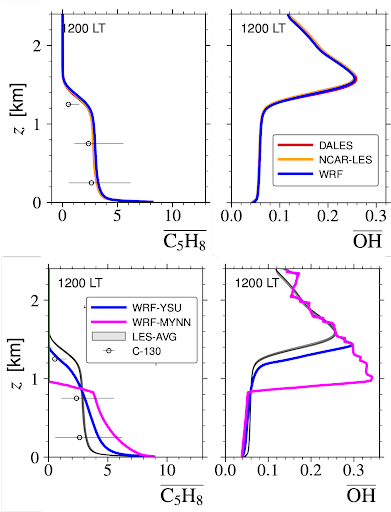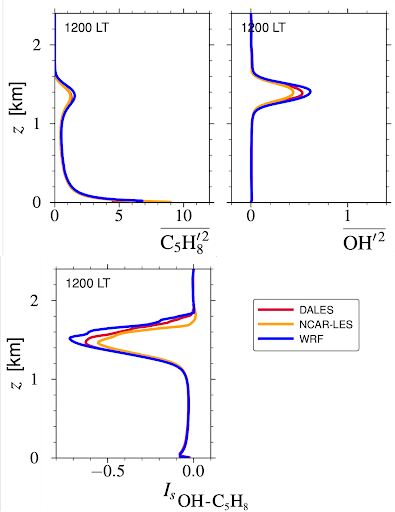Modeling Chemistry in the Boundary Layer
The atmospheric boundary layer (ABL) contains a complex set of processes that interact with each other. These processes include surface heat and moisture fluxes, turbulence, entrainment of air from the free troposphere, emissions, dry deposition, and chemical transformations. The NCAR-wide Boundary Layer Project has the goal to gain fundamental insights into these processes by developing combined modeling and observational analysis methodologies. The project is assessing boundary layer models, including large-eddy simulation (LES) codes that provide detailed characterization of ABL motions, physics, and chemistry and single column models (SCM) that allow easy comparison of LES results with boundary layer parameterization commonly used in regional and global models.
In 2020, ACOM assessed and improved the capability to run chemistry in WRF v4.0 configured both as a large eddy simulation (WRF-LES-Chem) and as a single column model (WRF-SCM-Chem) employing a simple chemical mechanism appropriate for low NOx and isoprene chemistry and for idealized conditions where the forcing is prescribed. The results of these two models are currently being compared to observations and to results from the chemistry-enabled NCAR LES and the Dutch Atmospheric LES (DALES). The simulations target the diurnal variation of the ABL for a typical day observed during the Southeast Atmosphere Study (SAS) in 2013 during a time period of relatively clean conditions and light winds. Observations from the NSF/NCAR C-130, ground-based instruments, and instruments on a tower are used to aid the configuration of the models and subsequently evaluate the models (with independent measurements).
Horizontally-averaged vertical profiles of isoprene (C5H8) from all three LES codes agree well with each other and with observations (Figure 1). Horizontally-averaged vertical profiles hydroxyl radical (OH) are also consistently simulated by all three LES codes. Two simulations were performed with the WRF-SCM-Chem, one with the Yonseii University (YSU) PBL scheme and another with the Mellor Yamada Nakanishi-Nino (MYNN) PBL scheme. These two simulations show substantially different vertical profiles of both horizontally-averaged isoprene and OH radial from the LES results, suggesting that these parameterizations need to be improved for trace gas transport.
The LES codes provide insight on variability of trace gases and co-variance of reactants. The latter is measured with the intensity of segregation (IS) defined as the ratio of the covariance of two reactants to the product of their average mixing ratios. The three LES codes agree with each other and show high horizontally-averaged isoprene variance at the surface where isoprene emissions are strong and at the top of the ABL. The horizontally-averaged OH variance is strongest at the top of the ABL where the three LES codes differ in the magnitude of the OH variance. Segregation between isoprene and OH occurs at both the surface and at the top of the ABL where, again, the three LES models give different magnitudes of segregation. During the morning growth of the ABL, the intensity of segregation is notably larger throughout the ABL-depth. We highlight that this is an example of the importance of chemistry-dynamics interactions as we believe OH production is controlled by ozone photolysis in the morning and is predominantly in the downdrafts while surface emitted isoprene is in the updrafts. Production of OH from the NO2 + HO2 reaction becomes larger as the ABL grows and occurs more near the surface where NO is emitted, thus reducing the segregation impact at the surface by 12 LT.

